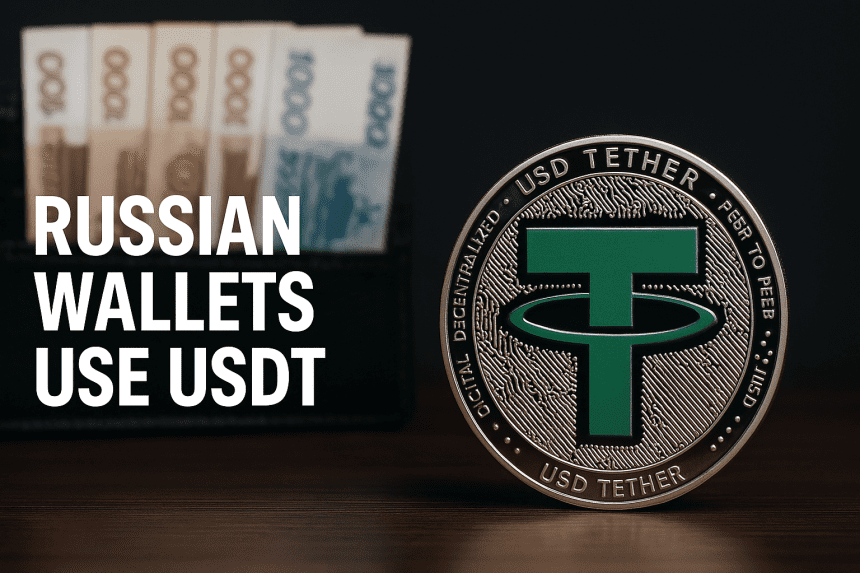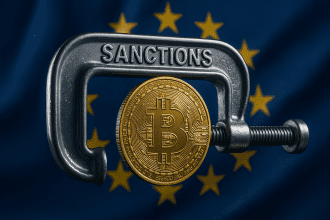A Wild West Problem Wearing a Suit and Tie: We all know crypto’s rebellious origin story. Close a door, and someone opens a window with code. That pattern is back in the spotlight after reports that a web of Russia linked wallets routed roughly $8 billion through Tether’s USDT, skirting Western sanctions with the speed and subtlety only stablecoins can deliver. The number is jaw-dropping not just for what it says about crypto’s scale, but for what it exposes about the plumbing of twenty-first-century finance, where borders are soft and liquidity flows to wherever the rules are thinnest. Recent coverage ties the activity to leaked data analyzed by blockchain forensics teams and media partners, emphasizing USDT’s central role in cross border value transfer beyond traditional rails.
What Actually Happened and Why It Matters Now:According to these reports, a cluster of wallets alleged to be connected to Russian state linked networks used stablecoins to keep commerce breathing while banks and intermediaries were choked off by sanctions. The bulk of the value rode on USDT, the dollar-pegged token that behaves like digital cash on crypto rails, keeping settlement fast and value stable compared to volatile assets such as Bitcoin or Ether. The headline estimate about $8 billion illustrates not a fringe experiment but a parallel financial channel big enough to move the needle on trade and enforcement.
Why USDT and Not Bitcoin?:Bitcoin captures the imagination, but it’s rarely the tool of choice when stability and tight spreads matter. Price swings can erase margins overnight, its transparent ledger makes large flows conspicuous, and its fiat ramps can be sticky. USDT, on the other hand, is the market’s lingua franca: liquid pairs on most exchanges, ubiquitous in peer-to-peer (P2P) markets, and easy to shuttle across multiple blockchains with minimal slippage. In short, it behaves like a settlement chip you can pass around the world in minutes precisely why it surfaces in both lawful commerce and sanctions evasion schemes. Broader industry research has repeatedly flagged stablecoins, including USDT, as the dominant medium in recent crypto-crime and sanctions evasion activity.
How Sanctions Are Supposed to Work And Where They Leak:Classic sanctions starve targets of oxygen: block access to SWIFT, freeze assets, jam dollar and euro pipes, and make counterparties too nervous to transact. The system is bank centric and jurisdiction bound. Crypto doesn’t care about jurisdictions. It’s a bearer asset internet of money, where wallets replace accounts, private keys replace bank officers, and stablecoins replicate dollars without touching a correspondent bank. That “accountless” architecture is the gap where enforcement struggles to get a grip.
The Backdoor in Plain Sight:Think of sanctions as a fortified front door. Crypto is a side gate accidentally left unlatched. Stablecoins make the gate quiet. With P2P desks and OTC brokers acting as liquidity bridges, sanctioned parties can convert local currency into crypto, stabilize it in USDT, route it through exchanges and wallets, and re-enter fiat in friendlier venues. Investigators can trace flows, but the mix of offshore entities, cross-chain hops, and human-layer intermediaries slows everything down just enough for trade to continue until a specific wallet or venue is named and shamed.
Eight Billion Dollars Is Not a Footnote:Eight billion dollars would be a rounding error to the global dollar system, but in the world of blocked accounts and constrained supply chains, it is a lifeline. It’s larger than the annual GDP of several micro economies and, more importantly, a proof of concept that sanctioned states can keep commerce alive without Western banks. The sum signals to copycats that the method scales and to regulators that the response must, too. Reports tie the activity to networks connecting Russia linked businesses and political influence operations in Moldova, further amplifying the geopolitical stakes as money and messaging converge.
Tether’s Central Role And Its Tightrope: USDT has lived with controversy for years: reserve transparency fights, sweeping adoption in volatile economies, and persistent claims that it oils both legitimate trade and the shadier kind. Law enforcement agencies have leaned on Tether at critical moments, and there is precedent for blocking addresses. In March 2025, after EU sanctions targeted Russian exchange Garantex, Tether blacklisted wallets on that venue, a move that pushed Garantex to suspend services and underscored how centralized control can bite when the pressure arrives.
So How Does the Money Actually Move?: Peel back the layers and a common pattern emerges. Rubles are gathered onshore. Brokers move value into crypto often via BTC or ETH for liquidity then quickly flip into USDT for stability. The tokens travel across a lattice of exchanges, OTC desks, and P2P markets before cashing out where banks are cooperative or controls are looser. Variants of this playbook have been described not just for Russia, but for other sanctioned economies as well. Enforcement bodies like the U.S. Treasury have explicitly called out stablecoins in sanctions-evasion typologies, naming networks that use digital assets to launder or move value across borders.
Why Stablecoins Keep Outrunning the Net: Trying to “ban Tether” would be like banning English from global trade. It operates offshore, is deeply embedded in crypto’s market microstructure, and settles an enormous share of daily volume. Exchanges, market makers, and merchants rely on USDT pairs; remove them abruptly and you destabilize order books, spreads, and liquidity. That interdependence encourages a scalpel rather than a sledgehammer targeted blacklists, exchange penalties, and pressure on specific venues while leaving the core token intact to avoid systemic shock. This tension defines today’s enforcement reality and explains why so much illicit activity flows through the same stablecoin everyone else uses.
The Rise of Ruble-Backed Rails and New Players: An emergent twist is the ascent of ruble-linked tokens like A7A5, which grew at breakneck speed after launch and became a weekday workhorse for cross-border business, according to analytics and investigative reporting. Its issuer sits beyond Western jurisdiction, while sanctioned Russian-connected exchanges provided distribution. The growth story around A7A5 demonstrates a strategic pivot if dollar stablecoins face friction, build a parallel settlement token and plug it into non-Western trade corridors. Western outlets have documented both the scale and the sanctions blowback around these rails.
A Digital Silk Road for Sanctioned Trade: Link these threads and a bigger picture comes into view: a crypto powered shadow economy knitting together Russia aligned businesses with partners across Asia, the Middle East, and parts of Africa and Latin America. It’s not decentralized utopia; it’s practical mercantilism. Stablecoins act as shipping containers for money, sliding through ports that don’t check for Western embargo stamps. When one harbor tightens, ships reroute. The throughput persists.
Systemic Risk and the Dollar’s Image: There is a reputational paradox here. USDT inherits trust from the dollar while operating outside the Federal Reserve’s domain. If stablecoins enable large scale sanctions leakage, then the perceived control that underpins dollar primacy gets dented at the margin. That doesn’t dethrone the dollar, but it does encourage actors to experiment with alternatives, from ruble backed tokens to bilateral settlement in non dollar currencies. Each workaround is a hairline crack; taken together, they’re a stress test for the architecture of economic statecraft.
Why Everyday Crypto Users Should Care: Even if you never touch a sanctioned address, policy hits the whole stack. Expect more stringent KYC on exchanges, stricter travel rule compliance for transfers, and faster address-screening rollouts. If regulators perceive USDT as a recurring sanctions hole, they will pressure centralized chokepoints exchanges, custodians, OTC desks to harden controls. That raises friction, sometimes fees, and occasionally delays. Liquidity can thin temporarily when a major venue or asset pair gets pushed offside. These are second order effects, but they reach retail traders all the same.
Could Tether Be Forced to Go Harder on Blocks?: There is precedent for Tether freezing addresses, and regulators have learned that pushing a few strategically important buttons can move mountains. The Garantex episode proves that when sanctions name a venue and the political will is there, wallet freezes follow. The debate now is whether that reactive model is enough. Policymakers could demand more proactive screening and blacklist propagation, transforming USDT governance into something much closer to a permissioned network. That would alter USDT’s value proposition for gray market activity, and potentially nudge flows toward other stablecoins or freshly minted ruble linked rails.
What the Next Enforcement Wave Might Look Like: The immediate toolkit is familiar: more designations of wallets and OTC brokers, civil and criminal actions against non-compliant exchanges, and interagency pressure on payment processors. But the larger arc points to structural change. We should expect experiments with programmable compliance at the token level, where asset issuers and chain infrastructure collaborate to embed screening and circuit-breakers. It won’t be perfect nothing in markets is but it will narrow the evasive surface area.
Enter the State CBDCs and the Competitive Dollar: Governments are not sitting still. Central Bank Digital Currencies (CBDCs) are inching from pilots to production, promising instant settlement with centralized compliance levers. Even without full CBDCs, expect “regulated stablecoin” frameworks to mature, especially in jurisdictions that want the efficiency of crypto rails without ceding control to offshore issuers. That trajectory aims to keep the convenience of stablecoins while reclaiming policy authority over who can use them and for what.
Will Decentralized Alternatives Fill Any USDT Gaps?: If USDT tightens controls, liquidity will seek the next deep pool. USDC has cleaner compliance optics but is more tightly tied to U.S. jurisdiction. Algorithmic models lack the scale and trust for large trade finance, especially after high profile collapses. Collateral backed decentralized stablecoins can play niche roles, but their capacity and fiat off ramps are limited compared to USDT’s sprawling network. That asymmetry is precisely why enforcement focuses on centralized chokepoints: move them, and the market moves with them.
A Cat and Mouse Game With Serious Stakes: Enforcement is never a one and done. Investigators attribute flows, issue designations, and coordinate with allies. Networks adapt, hop chains, and cultivate new brokers. Each side learns and iterates. The $8 billion case studies do not prove sanctions are futile; they prove that response speed and coordination must match the internet’s tempo. That is happening. Treasury actions have detailed how specific networks blend traditional front companies with digital asset rails and have pledged to keep striking the connective tissue that makes these schemes scale.
The Narrative War Headlines, Hype, and Hard Numbers: It is tempting to read any single leak or report as the whole story. It isn’t. Crypto’s transparent ledgers mean large parts of the truth are discoverable, but human intermediaries still muddy the picture. Different teams will arrive at different totals depending on methodologies and inclusion criteria. What’s undebatable is the direction of travel stablecoins have become the default settlement medium on crypto rails, and that makes them irresistible to sanctioned actors seeking dollar like stability without dollar based oversight. Multiple independent outlets and analytics shops have converged on that basic fact pattern.
Where This Leaves Markets: Short term, enforcement waves create volatility pockets: delistings, liquidity migrations, and brief spreads widening. Medium term, compliance hardens at the edges on and off ramps, OTC desks, custodians while core market structure adapts. Long term, we get a bifurcated landscape sanctioned corridors running on bespoke tokens and shadow liquidity, lawful corridors running on regulated stablecoins and, eventually, CBDCs. The connective grey tissue shrinks but never disappears. Markets rarely go to zero; they reroute.
The Bottom Line: The reported $8 billion of flows through USDT is not merely a headline; it is a stress test of the global system’s ability to enforce rules in an age of programmable money. It exposes how quickly capital reorganizes when incentives demand it and how imperfectly twentieth century tools police twenty first century networks. The more the world digitizes value, the more sanctions policy must digitize, too. That evolution is already under way, and the next chapter will be written in the code of tokens and the policies that govern them.
Conclusion: Freedom, Control, and the Friction in Between Crypto has always lived between ideals and incentives. It empowers individuals, unbundles gatekeepers, and connects markets that politics would rather keep apart. That duality is why it’s beloved by entrepreneurs and eyed warily by policymakers. The $8 billion saga is a wake up call, not a eulogy. Regulators will tighten, issuers will adapt, networks will detour, and users lawful and otherwise will keep seeking the path of least resistance. Somewhere between freedom and control lies the next stable equilibrium. The one certainty is that the pursuit of it will be loud, messy, and very, very real.






















